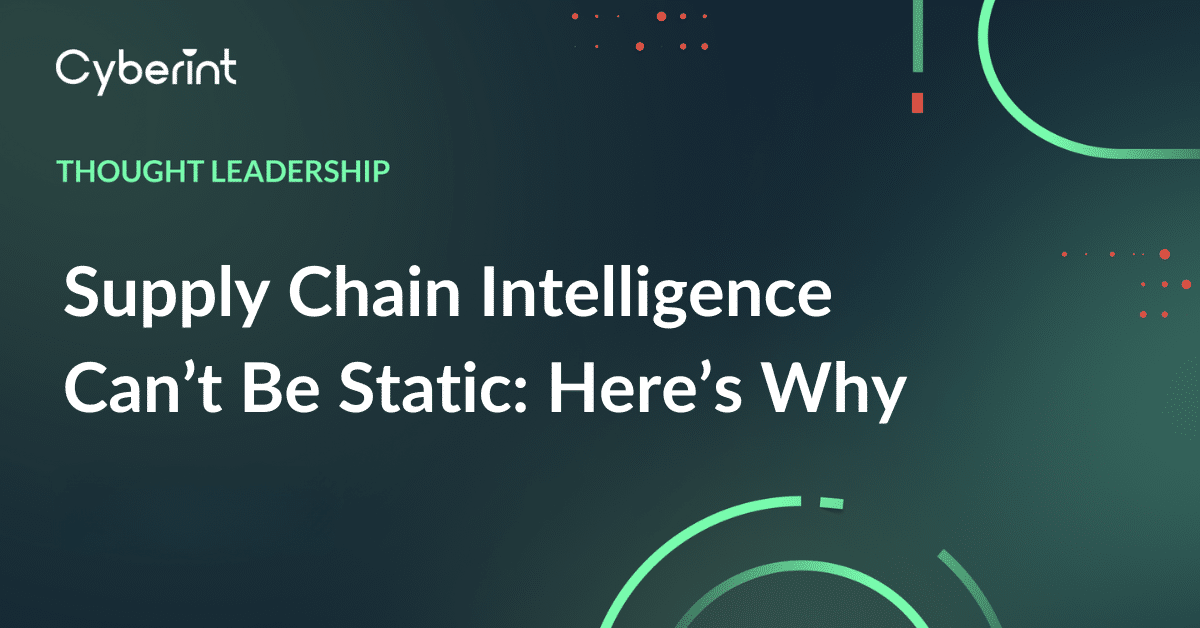


Jacob is a seasoned professional with over 12 years of experience in various roles within the intelligence and sales fields. Before embarking on his career, he served for 4 years in the Israeli intelligence special forces, where he developed a strong foundation in leadership, teamwork, and attention to detail.
Supply Chain Intelligence is an improved method for continuously discovering, monitoring, assessing and mitigating risk introduced to your organization through 3rd party technologies, vendors, and suppliers.
Supply chain attacks are on the rise. In 2022 19% of breaches were supply chain attacks, causing a whopping $4.46 M of damage per incident, on average. 62% of system intrusion events occurred through the supply chain.
Why are supply chain attacks becoming so common and costly? There are a few reasons:
The traditional approach of managing supply chain cybersecurity risk is far from complete. The following limitations are putting companies at risk of major breaches:
While static risk scans may offer a “snapshot” score to assess a company’s security posture, such an approach can lead to a false sense of security and a failure to fully mitigate risk. Even companies with top security scores can fall victim to breaches, regardless of how recently their score was assessed. In today’s rapidly evolving threat landscape, relying on a static risk score is inadequate and puts organizations at risk. As a result, a more proactive and dynamic approach is needed to provide real-time risk assessments and threat intelligence, enabling companies to better protect their assets and mitigate risk.
To effectively manage supply chain risk, continuous discovery and monitoring of vendors and third-party technologies is critical. This involves real-time assessment of vendor risks and the assignment of scores that are continuously updated to reflect changes in the vendor’s security posture. Any indications of targeted attacks or evidence of a breach should also be factored into the risk score.
In addition to scoring vendors based on their exposure and cyber hygiene, it is essential to identify and monitor shadow vendors that may have been overlooked. All vendors must be discovered, not just those that have been logged or reported by employees.
So, how can organizations achieve this level of supply chain intelligence?
It is crucial to maintain a complete and up-to-date inventory of your supply chain, including shadow vendors and technologies that may have been added without the knowledge of your security team. To achieve this, attack surface monitoring can be employed to discover new vendors, and manual vendor addition should be an option when onboarding new vendors.
The risk score mentioned earlier must be continuously utilized against each vendor in your inventory to assess potential risk and prevent the implications of a major supply chain attack. By maintaining an up-to-date inventory that includes risk scores, organizations can make informed risk management decisions while accurately reporting to stakeholders.
A risk score needs to be correlated between 3 components that update in real time, so that attacks and risks are not missed. The components are:
3) Real-time alerting when the risk score rises.
As the risk score of vendors and third-party technologies continuously updates, organizations must ensure that they are promptly alerted to any significant security events related to them. Accurate and real-time alerts play a critical role in this process, enabling security teams to proactively respond to potential threats and prevent them from causing any major disruptions.
alerts must seamlessly integrate with existing workflows via integrations with SIEM, XDR, and SOAR platforms.
A reliable supply chain intelligence solution should provide detailed information on each vendor’s level of organizational access, alongside their risk score. This contextual information can help security teams determine how urgently they need to deal with a high-risk vendor and take appropriate actions.
Traditional approaches that rely solely on Attack Surface Monitoring are not enough for addressing supply chain risks. A supply chain intelligence solution that integrates Attack Surface Monitoring with threat intelligence can offer a significant advantage.
At Cyberint, we have developed a cutting-edge module that directly addresses this challenge. Our Supply Chain Intelligence module enables automated discovery of third-party technologies and vendors and provides continuous monitoring for breaches and other relevant risks. As soon as a risk is identified, our module sends targeted alerts that enable a proactive response and mitigation.
Learn more about our supply chain intelligence solution here.
Fill in your business email to start


